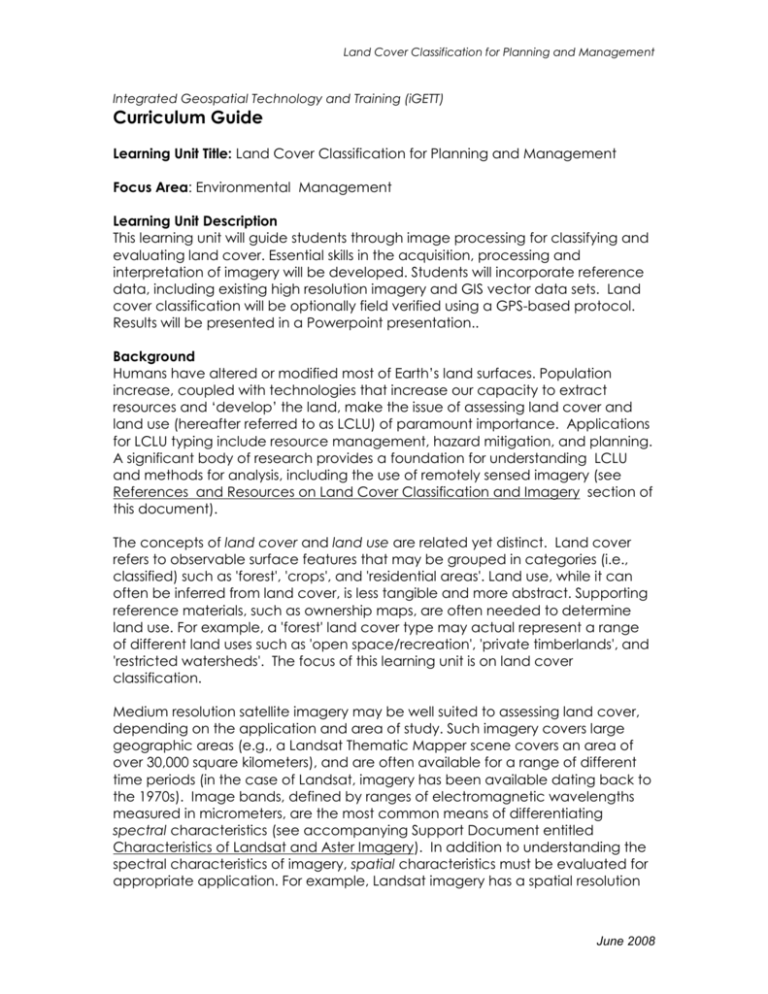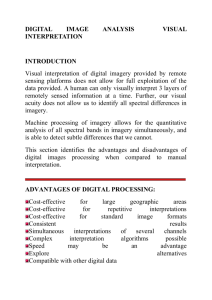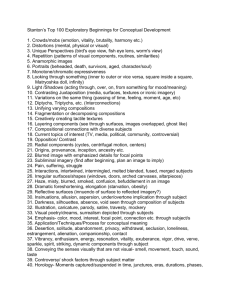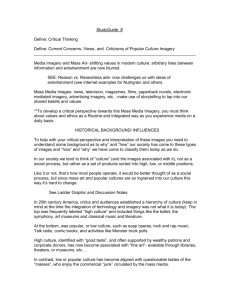LandCover_CS_06_2008 - Integrated Geospatial Education and
advertisement

Land Cover Classification for Planning and Management Integrated Geospatial Technology and Training (iGETT) Curriculum Guide Learning Unit Title: Land Cover Classification for Planning and Management Focus Area: Environmental Management Learning Unit Description This learning unit will guide students through image processing for classifying and evaluating land cover. Essential skills in the acquisition, processing and interpretation of imagery will be developed. Students will incorporate reference data, including existing high resolution imagery and GIS vector data sets. Land cover classification will be optionally field verified using a GPS-based protocol. Results will be presented in a Powerpoint presentation.. Background Humans have altered or modified most of Earth’s land surfaces. Population increase, coupled with technologies that increase our capacity to extract resources and ‘develop’ the land, make the issue of assessing land cover and land use (hereafter referred to as LCLU) of paramount importance. Applications for LCLU typing include resource management, hazard mitigation, and planning. A significant body of research provides a foundation for understanding LCLU and methods for analysis, including the use of remotely sensed imagery (see References and Resources on Land Cover Classification and Imagery section of this document). The concepts of land cover and land use are related yet distinct. Land cover refers to observable surface features that may be grouped in categories (i.e., classified) such as 'forest', 'crops', and 'residential areas'. Land use, while it can often be inferred from land cover, is less tangible and more abstract. Supporting reference materials, such as ownership maps, are often needed to determine land use. For example, a 'forest' land cover type may actual represent a range of different land uses such as 'open space/recreation', 'private timberlands', and 'restricted watersheds'. The focus of this learning unit is on land cover classification. Medium resolution satellite imagery may be well suited to assessing land cover, depending on the application and area of study. Such imagery covers large geographic areas (e.g., a Landsat Thematic Mapper scene covers an area of over 30,000 square kilometers), and are often available for a range of different time periods (in the case of Landsat, imagery has been available dating back to the 1970s). Image bands, defined by ranges of electromagnetic wavelengths measured in micrometers, are the most common means of differentiating spectral characteristics (see accompanying Support Document entitled Characteristics of Landsat and Aster Imagery). In addition to understanding the spectral characteristics of imagery, spatial characteristics must be evaluated for appropriate application. For example, Landsat imagery has a spatial resolution June 2008 Land Cover Classification for Planning and Management (i.e., resolving power) of 30 meters. As such, it is appropriate for global and regional applications, but is generally of insufficient resolution for local applications. Aster imagery, by contrast, has a spatial resolution of 15 meters (i.e., twice the resolving power of Landsat) for the visible and very near infrared bands, and is therefore more appropriate for local analysis. For many applications it may be necessary to acquire high resolution imagery, such as Quickbird or Ikonos, with sub-meter spatial resolution (such imagery is costly and not addressed in this learning unit). Evaluating the spatial and spectral characteristics of imagery is an important aspect of learning effective use of remotely sensed imagery (USGS's EROS website is an excellent source for exploring this topic; http://eros.usgs.gov/products/satellite.html). Image processing for classifying land cover has important applications in the workplace. Resource management and planning organizations, both in the public and private sector, depend on accurate land cover maps. The U.S. Federal government manages vast areas of the western United States (roughly half of California's 100 million acres is federally owned). Therefore agencies such as the U.S. Forest Service, Bureau of Land Management, and National Park Service are potential employers. State agencies, such as the California Department of Water Resources, are also important users of land cover data. In the private sector, forestry, mining, transportation, engineering, and related companies require land cover information, and are therefore potential clients for remote sensing. Regional and global concerns, such as urbanization and climate change, require accurate land cover data for impact assessment and mitigation. Workers trained in remote sensing and GIS will be increasingly valued in coming years, as the need for accurate land cover mapping and related spatial data increases. Evaluation/Assessment Students will complete each of part of the Learning Unit (each Part includes a deliverable; see Student Guide) Student maps and charts will be evaluated for accuracy, documentation, and cartographic quality Presentation of resulting maps to a community organization or conference will be accompanied by an evaluation form. June 2008 Land Cover Classification for Planning and Management Timeline Learning unit to be completed over 16 or 20 hours (typically over four or five 4 hours labs sessions). The field validation is optional, since access to the geographic area of the learning unit (i.e., Redding), may not be feasible. Instructors may wish apply the basic procedures using data sets from their own geographic locales. Part 1 – Basics of imagery; viewing, characteristics, acquisition Part 2 – Image Processing with Unsupervised Classification; stack, subset, perform unsupervised classification, combine and clump classes, derive cell statistics Part 3 – Image Processing with Supervised Classification; delineate training sites, perform supervised classification, derive cell statistics Part 4 – Reference Data Integration and Interpretation of Results; evaluated classified images based on reference data, georeference images with vector data, produce Powerpoint with image maps, graphs, results Part 5 - Field validation (optional); locating sampling sites, implementing field protocol Scientific or Geographic Concepts Land use Land cover Raster Vector Unsupervised classification Supervised classification Spatial extent Spectral bands Pixel location Pixel value Sampling Field validation Key words Land cover Land use Image processing Image enhancement Vegetation indices Unsupervised classification Supervised classification Training sites GPS Field validation GIS integration Relevant Disciplines Geography Geographic Information Systems Environmental Science Fire Science Natural Resources Engineering/Surveying Author: Dan Scollon Institution: Shasta College Email: dscollon@shastacollege.edu June 2008 Land Cover Classification for Planning and Management June 2008








